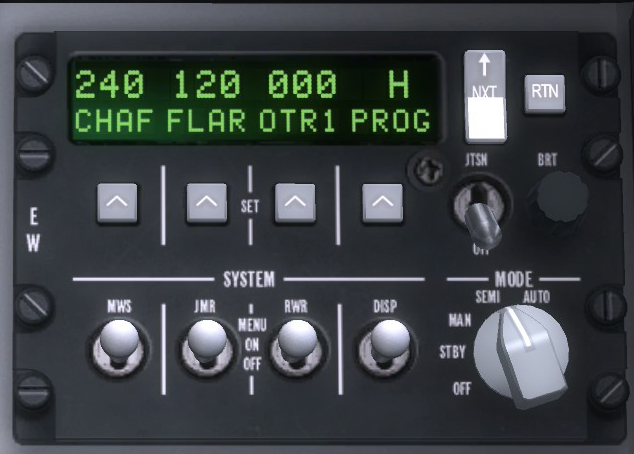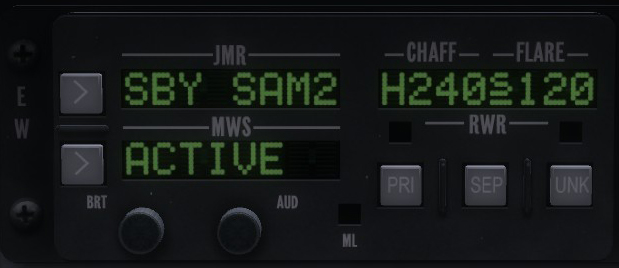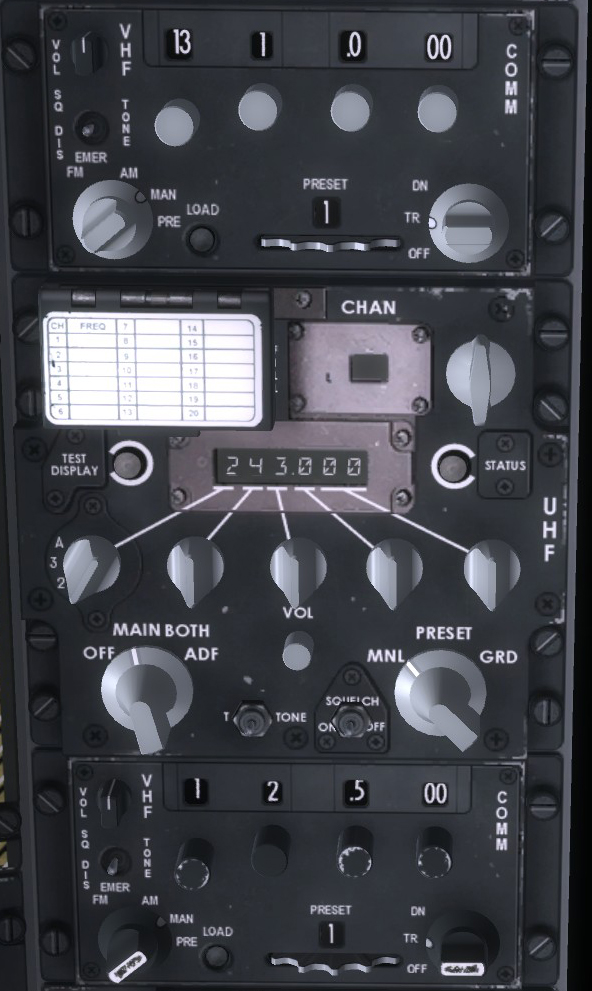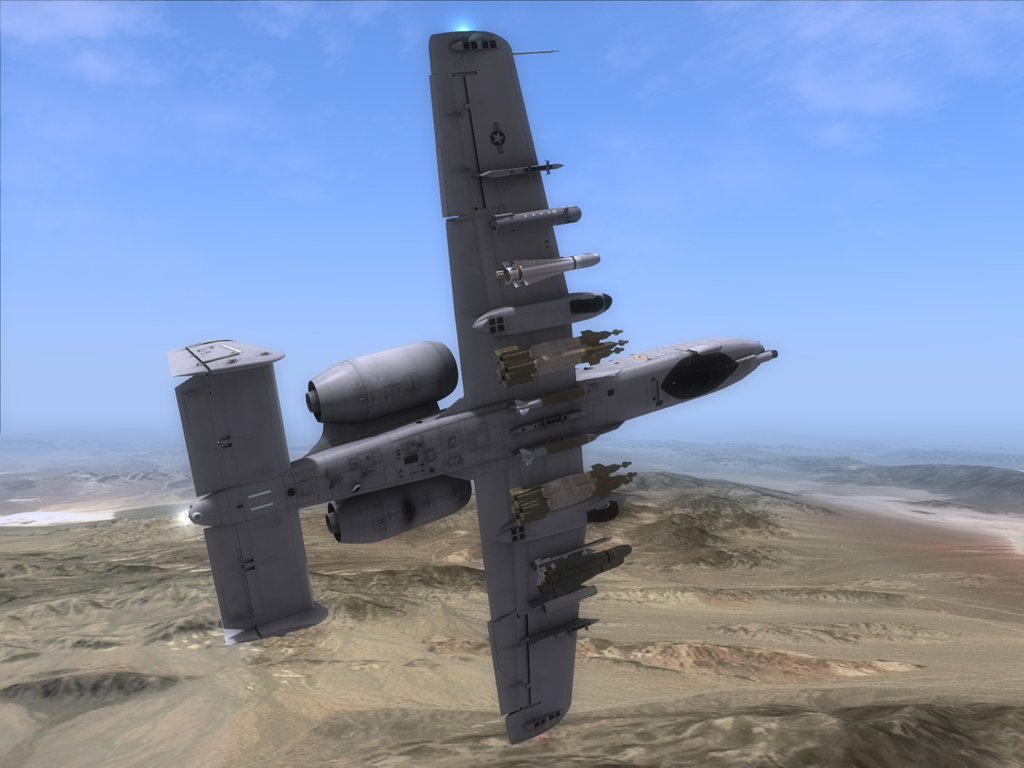DCS: A-10C Warthog is a PC simulation of the U.S. premier Close Air Support attack aircraft. This is the second aircraft in the DCS series, following DCS: Black Shark, and raises the bar even higher in the DCS series. Warthog brings the most realistic PC simulation of a modern fixed wing combat aircraft in regards to flight dynamics, avionics, sensors, and weapon systems. You also have the option to play Warthog in "Game" mode for a casual game experience. Fly missions in the Caucasus region of the Black Sea against and with a wide array of air, land and sea forces with new and improved intelligence. Create your own missions and campaigns with the included Mission and Campaign Editors, and fly with and against friends online using the included online game browser.
Countermeasure System (CMS)
Although first introduced in late-model A-10A jets, the CMS provides the pilot with much greater countermeasure flexibility, to include:
- OFF, Stand By, Semi-Automatic, and Automatic master modes.
- Programmable chaff and flare dispensers (enable and disable programs from HOTAS) with ability to create and save multiple programs.
- Multiple electronic countermeasure programs according to threat type. Self-protection jammer modeled that stays in Stand By mode unless aircraft is locked by hostile radar.
- Fully functional Radar Warning Receiver with Built In Test (BIT).
- AAR-47 Missile Warning System.
Radio Communications
The A-10C uses three radios: one UHF radio, one VHF AM radio, and one VHF FM radio. Each of these radios is interactive needs to be set accordingly to communicate with other aircraft and ground elements in the mission (manual and preset frequencies). Each friendly aircraft is assigned a frequency that a radio must be tuned to in order to communicate with it. This is also true for the JTAC. When viewing the radio message window, the frequency of recipients is listed.
The HOTAS Mic switch can be used to select each radio and only the possible recipients on the modulation and frequency will be listed in the radio dialog menu.
Flight Control System
Just like the A-10A, the A-10C uses a hydraulic-assisted flight control system. This system is modeled in detail in this simulation, as are the back-up direct linkage and using the electrical driven trim tabs (emergency modes). Manual Reversion, the Stability Augmentation System, Low Altitude Auto Pilot (LAAP), Enhanced Attitude Control (EAC), and the emergency flight control panel are included.
Armament of the A-10C
The GAU-8/A 30mm cannon can be loaded with three types of ammunition:
- TP - Training rounds
- HEI - High Explosive Incendiary rounds
- CM - Combat Mix that combines HEI and armored piercing rounds
Rocket Types
- MK1. Explosive warhead
- MK5. Explosive warhead
- MK61. Training rocket
- M151. Explosive warhead
- M156. Smoke warhead with white phosphorus
- WTU1B. Training rocket
- M274. Smoke warhead
- M257. Illumination warhead
- M278. Illumination warhead
Unguided Bombs
- Mk-82. A 500-pound bomb with 87 kilograms Tritonal is the most widely used A-10C unguided bomb. It provides a good options against unarmored and lightly armed targets using shrapnel and blast effects.
- Mk-82AIR. This version of the Mk-82 is an aerodynamically retarded BSU-49 / B. This allows the bomb to quickly slow after release, which enables use at low altitudes. This bomb can also be dropped in low drag mode depending on the DSMS fuze setting.
- Mk-84. The big brother of the Mk-82, it contains 906kg to 428kg H-6 or Tritonal. It's most effective against unarmored and soft-skinned targets, the Mk-84 could nevertheless be effective against armor, if impacting in sufficient proximity.
- CBU-87. "Combined Effects Munitions" CBU-87 is a 453-pound cluster bomb. It uses the SW-65 Tactical Distributor Sub-munitions dispenser that contains 202 BLU-97 cassettes; they are effective against both armored and unarmored objectives.
- CBU-97. The CBU-97 consists of an SUU-66/B tactical munitions dispenser that contains 10 BLU-108 submunitions. Each submunition contains four hockey-puck-shaped sensor-fused projectiles called Skeets. These detect targets, such as tanks, armored personnel carriers, trucks and other support vehicles, and fire an explosively formed penetrator.
Unguided Training Bombs
- BDU-50LD. Training version of the Mk-82 with an inert warhead and low drag.
- BDU-50HD. Training version of the Mk-82 with an inert warhead and high drag.
- BDU-33. A small bomb to simulate on their aerodynamic characteristics of the larger Mk-82.
Illumination Flares
- LUU-2B / B. Illumination in the visible spectrum.
- LUU-19. Illumination in the infrared spectrum. Designed to improve the use of night vision devices.
Laser-Guided Bombs
- GBU-10 Paveway II. This laser-guided bomb variant of Mk-84.
- GBU-12 Paveway II. This laser-guided bomb variant of Mk-82.
Guided Bombs
- GBU-38. The standard Mk-82 with a GPS-guidance set.
- GBU-31. The standard Mk-84 with a GPS-guidance set.
- CBU-103. Standard CBU-87 with a Wind Corrected Munitions Dispenser (WCMD) INS-guidance set.
- CBU-105. Standard CBU-97 with a Wind Corrected Munitions Dispenser (WCMD) INS-guidance set.
AGM-65 Maverick
- AGM-65D. An infrared seeker and a directional 57kg warhead.
- AGM-65G. An infrared seeker and a 136-pound armor-piercing warhead.
- AGM-65H. A Charged Coupled Device (CCD) seeker and a 57kg warhead.
- AGM-65K. A Charged Coupled Device (CCD) seeker and a 136-pound warhead.
- TGM-65D. Training version of AGM-65D with inert motor and warhead.
- TGM-65G. Training version of AGM-65G with inert motor and warhead.
- CATM-65K. Training version of AGM-65K with inert motor and warhead.
- TGM-65H. Training version of AGM-65H with inert motor and warhead.
Pods
- Litening II AT targeting pod.
- Travel pod.
Air-to-Air Missiles
- AIM-9M. Short-range, infrared homing.
- CATM-9M. Training version of the AIM-9M with inert engine and warhead.
Improved Graphics
To further improve the visuals of DCS, we've added several new features that include:
- High Dynamic Range (HDR)
- Normal Maps
- Cirrus cloud layer
- 3D and Transparent Water
- Soft Shadows
- Low Altitude Clutter













